THE URBAN HOME & GARDEN
Home canning, preserving and
pickling!

Many backyard gardeners enjoy their bountiful harvests during the fall and winter months by canning their fruits and vegetables. Home canning has once again come into vogue as we strive for more sustainable lifestyles. As we make better-informed choices about what we eat, home canning also allows us to keep additives and preservatives out of our family’s diet. Even if you don’t have a garden, the farmers’ markets that are so abundant in the Bay Area are full of freshly picked and locally grown fruits and vegetables.
Home canning is not complicated. It is a simple procedure that applies heat to food in a closed glass jar to interrupt the natural decaying that would otherwise take place. There are two types of canning methods: water-bath canning and pressure canning. Pickling involves preserving foods with either vinegar or salt.
Water-bath canning (boiling jars of food in a hot water bath) is a quick and easy way to safely preserve high-acidity foods like as tomatoes and fruits. According to the Ball Blue Book Guide to Preserving, foods among the easiest to can are those with naturally high levels of acid. Mold, yeast and enzymes are the largest concern, but these are destroyed at a temperature of 212 degrees Fahrenheit, which is easily reached when using the boiling-water method.
Fruits harvested in season are also ideal for preserving, these include grapes, tomatoes, pears, peaches, nectarines, and apples, and they should be harvested or purchased only at the peak of flavor, texture and color. Fruit can be preserved whole, sliced, as a sauce, or juiced to provide versatility in serving and cooking. Fruity sauces, which are very easy to prepare, complement many entrees. Cooked apples, for example, pair nicely with pork chops.
Pressure canning is required for preserving low-acid foods such as carrots, green beans and most vegetables. The pressure method takes a little longer, but offers gardeners a way to can almost anything from their garden.
Consider picking up a copy of the Ball Blue Book Guide to Preserving ($8.49), first published in 1909 – it may have some of the same recipes that your grandmother used! Step-by-step, easy-to-follow instructions for over 300 recipes for canning jams, jellies, tomatoes, pickles, relishes, meats, fruit and vegetables are included.
Ball also still makes canning jars, lids and supplies – the same jars that your grandmother used when putting up her homegrown foods. The sizes of these jars have not changed for years, so if you have old mason jars, you can still buy lids to fit them.
Here is a list of some of the basic canning supplies you will want to have on hand:
• large pot
• mason jars
• jelly jars
• sturdy apple corer
• sturdy swivel peeler
• fruit pitter
• jelly bag for straining juice
• spice bag to infuse flavors
• canning jar lifter
• self-adhesive canning jar labels
• funnel
• sugar syrup for canning fruits
• spices or liqueur for flavoring
• pressure cooker for low-acid foods
Home canning can be a great family activity and a fun tradition to start with your children. Home-preserved foods make beautiful and heartfelt holiday gifts with a personal touch for friends, family and co-workers. Simply add a festive ribbon and label to your home creations and they’re gift-ready!
Julia Strzesieski is the marketing coordinator for Cole Hardware and can be reached at [email protected].


